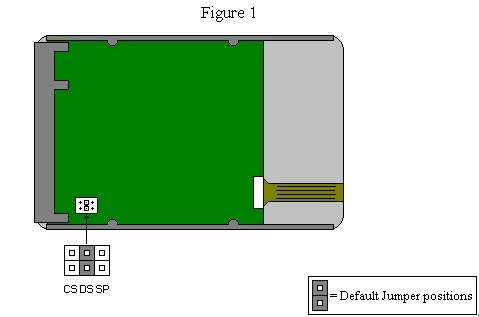Disks 2 Heads/Surfaces 4 Tracks per Surface 4,142 Sectors per Track 95 to 177 Bytes per Sector 512 Track Density 4,270 Encoding Method 16/17 PRML
Average Seek 12 ms Track-to-Track 3 ms Full Stroke 22 ms Rotational Speed 5,400 rpm Rotational Latencey 5.56 ms Disk-to-Buffer Data Rate 84 Mb/sec Buffer Size 128KB Host Data Transfer Rate 16.6 MB/sec (PIO Mode 4 / DMA Mode 2)
Operating Temperature 0 to 55 degrees C Non-Condensing Humidity 5 to 85 % Shock 10 G, 11ms Vibration 1 G, peak-to-peak Altitude -650 to 10,000 ft. Non-Operating Temperature -40 TO 75 degrees C Non-Condensing Humidity 5 to 95 % Shock 70 G, 11ms Vibration 2 G, peak-to-peak Altitude -650 to 40,000 ft.
Width - inches / mm 4.0 / 101.6 Length - inches / mm 5.75 / 146.1 Height - inches / mm 1.0 / 25.4 Weight - pounds / kg 1.2 / 0.55
+5VDC +12VDC Idle 310 mA 220 mA Random Seeking 400 mA 710 mA
Cylinder 2484 Heads 16 Sectors 63 Write Precomp 65535* Landing Zone 2484
*= The Quantum Fireball II does not require Write Pre compensation, your CMOS setting should be set to reflect that this feature is not enabled. A value of 65535 is a number that many BIOS manufactures use to disable this feature if the value 'none' is not present.
The Fireball 1280AT has three drive mode jumper options; DS, SP and CS. To configure the drive as:
The SP jumper is only used when the second drive in a two drive
configuration does not support DASP. DASP (Drive active / drive
1 present) is a CAM (Common Access Method) defined signal that
indicates the presence of a second drive, DASP is used during
power on initialization and after a reset. Prior to this definition,
products were introduced which did not utilize this method to
detect the presence of a second drive. The SP jumper is only used
on the MASTER drive, with the DS jumper, when the second drive
does not support DASP.
The CS (Cable Select) jumper is only used in systems that support
this feature. Cable Select allows for each IDE disk drive to be
jumped the same and the position on the cable determines the ID.
This requires special cable and both drives on the interface would
have to support this feature.
